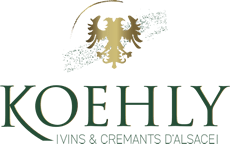Alsace Tradition
Original, frank and lively, the wines in this range are rooted in the youthfulness and true sincerity of expression of the Sylvaner, Pinot Auxerrois, Riesling and Muscat grape varieties; not forgetting the Edelzwicker (blending wine).
Read more...Our Alsaces Tradition are wines to be drunk young (keeping time: 5 years). Very often the youth of our wines offers a slightly sparkling show in the glass due to a small proportion of carbon dioxide still dissolved and coming from the alcoholic fermentation.
Alsace Lieux-Dits et Grands Crus
The locality "Hahnenberg" terroir straddles the town and Kintzheim Châtenois. It offers East - South-East exposure with a low to medium slope, at an altitude of 210 to 530 m.
Read more...Its main feature is an acid brown stony soil most often on granite surface. There are also a few streaks of sandstone and a small area of limestone outcrop in Kintzheim. The typical characteristics of this soil are an extraordinary heterogeneity that allows a local-match variety of different grape varieties.
Grand Cru Gloeckelberg "located on the bank of the town of Rodern, annexing several parcels in the commune of Saint-Hippolyte, extending to a small hill between the two villages, this locality is South - South-east facing at an altitude of 250 to 360 m.
It rests on a granite substrate. Acid brown and course sandy soil may be more or less clay in contact with shale and sandstones of the Carboniferous and the pink sandstone which crown the hill. Of great homogeneity, the soil has a steep slope at the top, but gradually softens lower down.
Often the youth of this wine shows a little beading of bubbles in the glass due to a small proportion of dissolved carbon dioxide and even from the fermentation.
Cremant d'Alsace
The AOC Crémant d'Alsace crowns the sparkling wines of Alsace, lively and delicate, made with a second fermentation, mostly from Pinot Blanc but also Pinot Gris, Pinot Noir, Riesling or Chardonnay.
Read more...These varieties are usually harvested at the beginning of the opening of the harvesting period, the time where the grape is at its best for winemaking and at the best of its balance and fine harmony.
At the beginning of last century, several Alsatian wineries made sparkling wines using the Champagne method. This tradition, less used in the first half of the twentieth century, was maintained until the recognition of the AOC Crémant d'Alsace, by the decree of August 24, 1976. The decree gave the Alsace winemakers the new framework necessary to develop a quality sparkling wine according to requirements comparable to those applied by the Champagne professionals themselves. Today more than 500 winemakers are in the Union of Producers of Crémant d'Alsace.
The traditional method of making sparkling wine is split into two main steps. The first is a fermentation tank identical to all wines called "non sparkling" to get a base with an alcohol content of approximately 10% Vol. and characteristics of the grape variety used (Riesling or Pinot Noir). The second step is fermentation in the bottle after adding yeast and sugar giving the sparkle the natural way (different to mousseux type sparkling wines, where in this case only, the carbon dioxide is added directly). For a sparkling wine, the final step is the "bleeding" which is to remove the yeast deposit. After turning, the deposit is frozen in order to extract it. At this point, we add, or not, a liquor for shipping that is the signature of each winemaker (without adding the liquor, it is called Crémant Brut de tirage).
Alsace Pinot Noir
Cuvée Prestige
Our selection of exceptional products from our Alsace wine production.

Late Harvest and Selection de Grains Nobles
Late Harvest and Selection de Grains Nobles are exceptional wines with a grand elegance. In our winery, we make a specialty of these strong, soft and sweet wines.
Read more...The sub-continental climate of our vineyard with its very low rainfall and sunshine in autumn, is highly favourable to the ripening of the grapes on the vine and in the development of noble rot (Botrytis cinerea). It allows the harvesting of late grapes such as Gewurztraminer, Pinot Gris and Riesling, at the moment they offer all their opulence.
The aromas of the variety and strength of these wines are accentuated by the phenomenon of concentration of sugars due to dehydration of the grapes and the development of noble rot.
The late harvest and selection of noble grapes, which must have a particularly high sugar content at harvest (the minimum required is, along with straw wines of the Jura, the highest of any French AOC) are wines of an exceptional class.
From a gastronomic point of view, these wines are wines for aperitifs par excellence, the most agreeable companion to foie gras with a hint of jam and decorated with a little salt. It is also possible to associate them with strong cheeses.








































